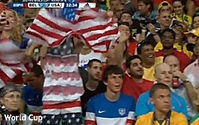 The 2014 World Cup has challenged conventional advertising with sponsors turning to new and more interactive ways in engaging with fans. Now, there are many different approaches in how brands are
trying to be noticed, including athlete brand ambassadors, news hubs, social network accounts and in-the-moment dynamic media content.
The 2014 World Cup has challenged conventional advertising with sponsors turning to new and more interactive ways in engaging with fans. Now, there are many different approaches in how brands are
trying to be noticed, including athlete brand ambassadors, news hubs, social network accounts and in-the-moment dynamic media content.
"We have reached somewhat of a perfect storm with general
interest level of the World Cup at heightened levels. due to the U.S. team’s success, the friendly time zone of games, the tournament being hosted by the stylistic birthplace of soccer being
Brazil and the Olympic-like patriotism that has engulfed this nation," says Josh Farber, account director, Omnicom Media Group's Optimum Sports.
"While the U.S. team definitely drives a
lot of this, it’s also the beauty of the U.S. in general, being a melting pot of cultures, that all tend to gravitate toward the beautiful game. These interest levels have translated to
increased viewership levels on Univision and ESPN, increased social commentary and an increase in overall editorial coverage across expected and unexpected sources," he added.
advertisement
advertisement
Omnicom Media
Group's international research team -- which monitors and analyzes media usage, consumer behaviors and attitudes and social conversations and engagement around global sports events -- has been
tracking social conversations and buzz around brands to find which brands are scoring big, and which are missing their goals during this big event.
For one, it's important to act globally, but
think about how local markets might react. For instance, Burger King in Russia has introduced Kurinho and Goal-Burgers, and guests who yell "Go Russia" while ordering French fries receive a discount.
This World Cup integration is also expanded to other countries and is supported by the Whopper Fanatic ad. Indeed, this locality can translate to other countries by building upon regional
excitement.
Secondly, brands need to adopt a relevant, fun and human tone of voice. For example, EA Sport FIFA turned the fact that the U.S. team turned down soccer star Landon Donovan
into a humorous spot that featured him lazing around his apartment and playing new EA Sport's World Cup video game in order to participate in World Cup action.
Also, the most successful brands
have frequent updates, including content that has eye-catching images in order to stand out. It is essential that brands use multiple platforms in a unison and complementary way, including both
traditional media, such as TV, with newer channels, such as Tumblr, Instagram, YouTube, Facebook and Twitter.
“As the U.S. Men’s National Team and Mexican National Team have
progressed from the group stage for a second straight World Cup, the TV viewership numbers have increased dramatically versus four years ago in the 2010 World Cup South Africa with ESPN climbing by
31% and Univision by 60%," says Farber.
"With this increased football interest, brands have been working tirelessly to take advantage of this engaged consumer. While some brands have been
carefully planning every step of their World Cup activation, others have chosen to react in real time to what has been unfolding," he notes.
"One brand among a few that executed this real-time
strategy brilliantly is Snickers, which reacted swiftly to the unfortunate actions of Uruguay’s Luis Suarez biting Italy’s Giorgio Chiellini in their final group stage match," says
Farber.
Ultimately, there is a strong link between the brands that are the most recalled and their online presence. Some 200 million people generated 815 million Facebook interactions and
300 million Tweets were recorded during the group stage of the World Cup.
Lastly, brands must engage their audiences by letting them interact with their brand or message in a personal way. As
such, Dos Pinos in Costa Rica, among others, has introduced a special Web site where visitors can send messages, create personalized avatars, and show their support.
Still, Omnicom
advises brands to apply caution when using certain teams and players; thinking about the worst case scenarios such as being eliminated in the group matches. For instance, if a brand built their entire
campaign expecting Asian countries to be in the finals, they would be out of luck.